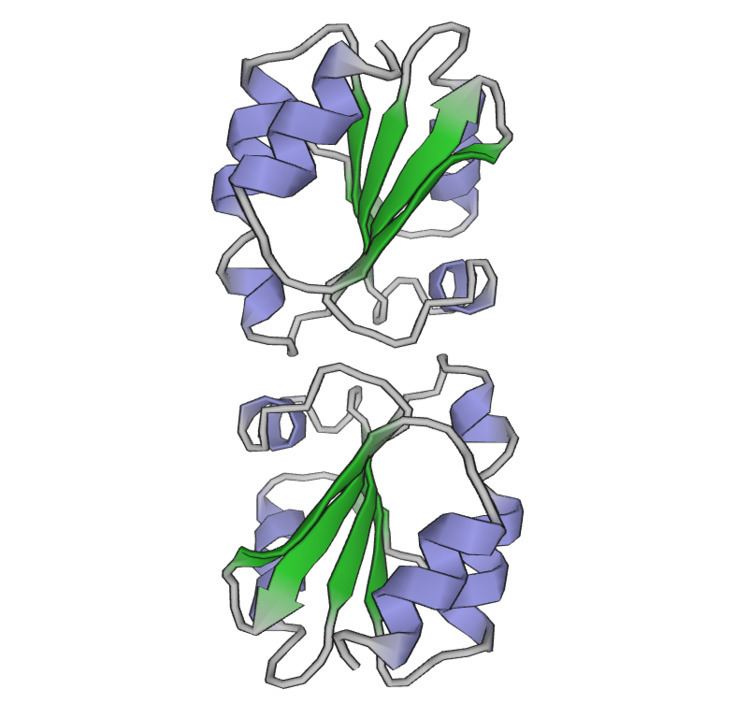Entrez 7295 | Ensembl ENSG00000136810 | |
 | ||
Aliases TXN, TRDX, TRX, TRX1, thioredoxin External IDs OMIM: 187700 MGI: 98874 HomoloGene: 128202 GeneCards: TXN | ||
Thioredoxin is a class of small redox proteins known to be present in all organisms. It plays a role in many important biological processes, including redox signaling. In humans, thioredoxins are encoded by TXN and TXN2 genes. Loss-of-function mutation of either of the two human thioredoxin genes is lethal at the four-cell stage of the developing embryo. Although not entirely understood, thioredoxin plays a central role in humans and is increasingly linked to medicine through their response to reactive oxygen species (ROS). In plants, thioredoxins regulate a spectrum of critical functions, ranging from photosynthesis to growth, flowering and the development and germination of seeds. It has also recently been found to play a role in cell-to-cell communication.
Contents
Function
Thioredoxins are proteins that act as antioxidants by facilitating the reduction of other proteins by cysteine thiol-disulfide exchange. Thioredoxins are found in nearly all known organisms and are essential for life in mammals.
Thioredoxin is a 12-kD oxidoreductase enzyme containing a dithiol-disulfide active site. It is ubiquitous and found in many organisms from plants and bacteria to mammals. Multiple in vitro substrates for thioredoxin have been identified, including ribonuclease, choriogonadotropins, coagulation factors, glucocorticoid receptor, and insulin. Reduction of insulin is classically used as an activity test.
Thioredoxins are characterized at the level of their amino acid sequence by the presence of two vicinal cysteines in a CXXC motif. These two cysteines are the key to the ability of thioredoxin to reduce other proteins. Thioredoxin proteins also have a characteristic tertiary structure termed the thioredoxin fold.
The thioredoxins are kept in the reduced state by the flavoenzyme thioredoxin reductase, in a NADPH-dependent reaction. Thioredoxins act as electron donors to peroxidases and ribonucleotide reductase. The related glutaredoxins share many of the functions of thioredoxins, but are reduced by glutathione rather than a specific reductase.
The benefit of thioredoxins to reduce oxidative stress is shown by transgenic mice that overexpress thioredoxin, are more resistant to inflammation, and live 35% longer — supporting the free radical theory of aging. However, the controls of this study were short lived, which may have contributed to the apparent increase in longevity.
Plants have an unusually complex complement of Trxs composed of six well-defined types (Trxs f, m, x, y, h, and o) that reside in different cell compartments and function in an array of processes. In 2010 it was discovered for the first time that thioredoxin proteins are able to move from cell to cell, representing a novel form of cellular communication in plants.
Mechanism of action
The primary function of Thioredoxin (Trx) is the reduction of oxidized cysteine residues and the cleavage of disulfide bonds. For Trx1, this process begins by attack of Cys32, one of the residues conserved in the thioredoxin CXXC motif, onto the oxidized group of the substrate. Almost immediately after this event Cys35, the other conserved Cys residue in Trx1, forms a disulfide bond with Cys32, thereby transferring 2 electrons to the substrate which is now in its reduced form. Oxidized Trx1 is then reduced by thioredoxin reductase, which in turn is reduced by NADPH as described above.
Interactions
Thioredoxin has been shown to interact with:
Effect on cardiac hypertrophy
Trx1 has been shown to downregulate cardiac hypertrophy, the thickening of the walls of the lower heart chambers, by interactions with several different targets. Trx1 upregulates the transcriptional activity of nuclear respiratory factors 1 and 2 (NRF1 and NRF2) and stimulates the expression of peroxisome proliferator-activated receptor γ coactivator 1-α (PGC-1α). Furthermore, Trx1 reduces two cysteine residues in histone deacetylase 4 (HDAC4), which allows HDAC4 to be imported from the cytosol, where the oxidized form resides, into the nucleus. Once in the nucleus, reduced HDAC4 downregulates the activity of transcription factors such as NFAT that mediate cardiac hypertrophy. Trx 1 also controls microRNA levels in the heart and has been found to inhibit cardiac hypertrophy by upregulating miR-98/let-7.
